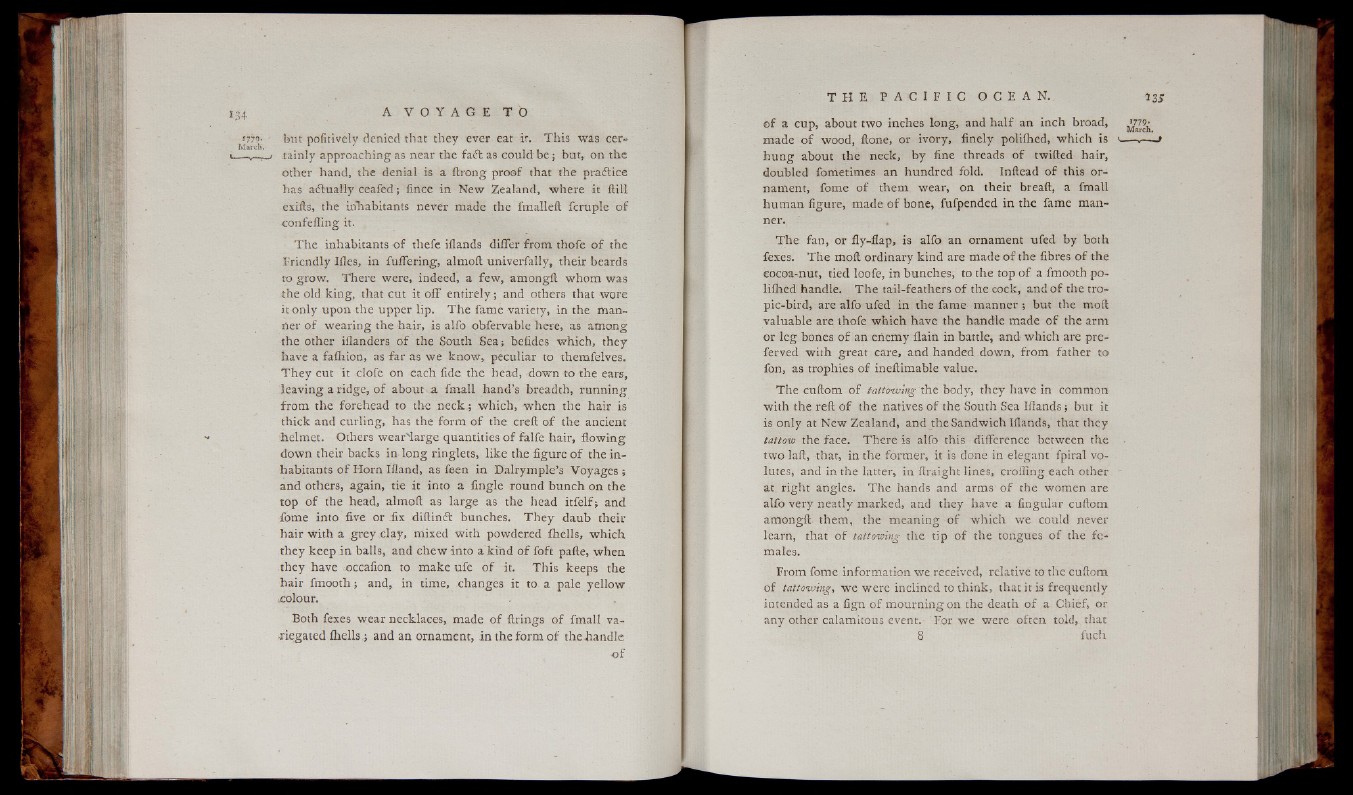
but pofitively denied that they ever eat it. This was certainly
approaching as near the fa it as could b e ; but, on the
other hand, the denial is a ftrong proof that the praftice
has aitually ceafed; fince in New Zealand, where it {till
exifts, the inhabitants never made the fmalleft fcruple of
confeffing it.
The inhabitants o f thefe iilands differ from thofe o f the
Friendly Iiles, in fuffering, almolt univerfally, their beards
to grow. There were, indeed, a few, amongft whom was
the old king, that cut it off entirely; and others that wore
it only upon the upper lip. The fame variety, in the manner
o f wearing the hair, is alfo obfervable here, as among
the other illanders o f the South Sea; beiides which, they
have a fafliion, as far as we know, peculiar to themfelves.
They cut it clofe on each fide the head, down to the ears,
leaving a ridge, o f about a fmall hand’s breadth, running
from the forehead to the n e c k ; which, when the hair is
thick and curling, has the form o f the creft o f the ancient
helmet. Others wear'large quantities o f falfe hair, flowing
down their backs in long ringlets, like the figure o f the inhabitants
o f Horn Ifland, as feen in Dalrymple’s Voyages ;
and others, again, tie it into a fingle round bunch on the
top o f the head, almoft as large as the head itfelf; and
fome into five or .fix diftinit bunches. T h e y daub their
hair with a grey clay, mixed with powdered fhells, which
they keep in balls, and chew into a kind o f foft pafte, when
they have occafion to make ufe o f it. This keeps the
hair fmooth; and, in time, changes it to a pale yellow
colour.
Both fexes wear necklaces, made o f firings o f fmall variegated
fh e lls ; and an ornament, in the form o f the handle
-of
o f a cup, about two inches long, and half an inch broad, jjggt
made o f wood, flone, or ivory, finely poliihed, which is \— .— -»
hung about thé neck, by fine threads o f twilled hair,
doubled fometimes an hundred fold. Inftead o f this ornament,
fome o f them wear, on their breaft, a fmall
human figure, made o f bone, fufpended in the fame manner.
The fan, or fly-flap, is alfo an ornament ufed by both
fexes. The moil ordinary kind are made o f the fibres o f the
cocoa-nut, tied loofe, in bunches, to the top o f a fmooth poliihed
handle. The tail-feathers o f the cock, and o f the tro-
pic-bird, are alfo ufed in the fame manner ; but the molt
valuable are thofe which have the handle made o f the arm
or leg bones o f an enemy flain in battle, and- which are preferred
with great care, and handed down, from father to
fon, as trophies o f ineflimable value.
The cuftom o f tattowing the body, they have in common
with the reft o f the natives o f the South Sea Iilands ; but it
is only at New Zealand, and the Sandwich Iilands, that they
tattow the face. There is alfo this difference between the
two lail, that, in the former, it is done in elegant fpiral volutes,
and in the latter, in ftraight lines, croffing each other -
at right angles. The hands and arms' o f the women are
alfo very neatly marked, and they have a Angular cuftom
amongft them, the meaning o f which we could never
learn, that o f tattowing the tip o f the tongues o f the fe males.
From fome information we received, relative to tlie cuftom
o f tattowing, we were inclined to think, that it is frequently
intended as a fign o f mourning on the death o f a Chief, or
any other calamitous event. For we were often told, that
8 fuch